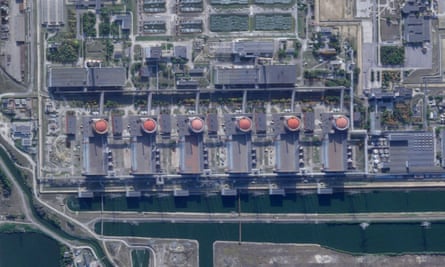A team of inspectors from the UN nuclear watchdog is due to arrive in Kyiv on Monday night en route to the Zaporizhzhia nuclear power in southern Ukraine, where renewed shelling has cast a shadow over their planned visit.
The International Atomic Energy Agency (IAEA) chief, Rafael Grossi, said on Monday morning that a team led by him had set off to visit the power station on the Dnieper River. “We must protect the safety and security of Ukraine’s and Europe’s biggest nuclear facility,” Grossi tweeted.
The day has come, @IAEAorg's Support and Assistance Mission to #Zaporizhzhya (ISAMZ) is now on its way. We must protect the safety and security of #Ukraine’s and Europe’s biggest nuclear facility. Proud to lead this mission which will be in #ZNPP later this week. pic.twitter.com/tyVY7l4SrM
— Rafael MarianoGrossi (@rafaelmgrossi) August 29, 2022
A spokesperson for Ukraine’s foreign ministry, Oleg Nikolenko, said the delegation would arrive in Kyiv on Monday night. They are due to visit the plant from Wednesday to Saturday, but missiles and shells are frequently hitting areas around the power station and nearby towns, and it may be too dangerous for the mission to proceed.
This IAEA mission’s arrival in Ukraine came as a spokesperson for Ukraine’s southern command said a long-awaited counteroffensive had started in Kherson province. Nataliya Humenyuk’s announcement came after a video circulated online that allegedly showed a soldier from the Russian-run self-proclaimed republic of Donetsk saying Ukrainian forces had broken through the first line of defence.
Humenyuk confirmed that there was a counteroffensive, but said the operation needed “silence” as media attention could affect the results. Her claims could not be independently corroborated.
Humenyuk said Russian forces were strong and that even though morale was low among their ranks, “it was too early to relax”. Western and Ukrainian military intelligence has noted a buildup of Russian troops and equipment this summer, suggesting Russia was preparing its own offensive.
However, Ukraine’s presidential adviser, Mykhailo Podolyak, warned politicians, experts and opinion leaders not to speculate about the progress of a military operation before Ukraine’s ministry of defence and army issued official statements.
“I understand our wishes and dreams … But war is not ‘content’. Let’s filter information and work professionally out of respect for our defenders,” he wrote on Telegram.
Captured by Russian troops in March but run by Ukrainian staff, Zaporizhzhia is a hotspot in a conflict that has settled into a war of attrition fought mainly in Ukraine’s east and south six months after Russia launched its invasion.
Ukraine’s president, Volodymyr Zelenskiy, said it was “abnormal” that Russia’s state nuclear agency, Rosatom, had not been placed under sanctions for using radiation as blackmail and intimidating Ukrainians and Europeans.
The plant’s satellite town, Enerhodar, also occupied by Russia, was hit overnight, causing fires in residential buildings and injuring at least 10 people, according to its mayor, Dmytro Orlov.
Russia and Ukraine have traded blame over the attack as well as previous attacks on and near the plant.
Ukraine claims that the attacks are false-flag operations carried out by Russia to damage the image of the Ukrainian army. But Russia says the attacks are being conducted by Ukraine.
Russia’s defence ministry reported more Ukrainian shelling at the power station over the weekend. Nine shells fired by Ukrainian artillery landed in its grounds, said the Russian defence ministry spokesperson, Igor Konashenkov. It has been impossible to verify either version of events.
The deputy head of Ukraine’s presidential administration, Andriy Yermak, said Russia was shelling Ukrainian-held territory and then simulating a “response”.
after newsletter promotion
The Ukrainian-held town of Nikopol and its neighbouring settlements, which lie across the river from the power station, were also hit on Sunday night, killing one woman and injuring two, according to the Dnipropetrovsk regional governor.
The Washington-based Institute for the Study of War has said Russia had failed to present evidence that the shelling was carried out by Ukraine, despite the fact that they controlled the territory.
The IAEA mission is made up of countries deemed neutral by Russia and does not include representatives from Britain or the US, according to a report in the New York Times.
Ukraine’s foreign minister, Dmytro Kuleba, said at a briefing on Monday that Ukraine expects the IAEA delegation to “state the facts” regarding the violation of all nuclear safety protocols.
Oleksandr Starukh, the head of Zaporizhzhia regional administration, said he was counting on the visit of the IAEA to result in the plant being demilitarised. “At a minimum, the enemy must leave the nuclear power plant as well as remove all its heavy weaponry and ammunition from there,” he told a press briefing.

Andriy Shapovalov, who monitors Russian propaganda for the Ukrainian government, said he believed it was probable that the delegation would reach the plant, but that Russia would try to convince the delegates that Ukraine was to blame for the situation.
“[Russia] is currently collecting signatures from people in Enerhodar under a statement demanding an end to the shelling of the nuclear plant, allegedly by Ukraine. In this way, the representatives of the aggressor country artificially create the conditions for the IAEA to draw the conclusions they need,” he said.
The world was on edge last week as fighting around the power station damaged the last remaining electricity line, causing it to disconnect from the main grid for the first time.
The power station requires electricity to power its cooling rods and security systems, without which engineers have 90 minutes to stave off dangerous overheating. During last week’s incident, a backup line to a local power station kicked in. The workers at the plant later reconnected it to the grid.
Reuters contributed to this report
